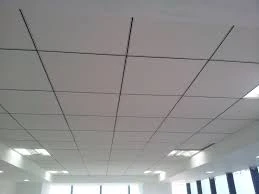Nov . 20, 2024 04:17 Back to list
suspended ceiling grid cost per square foot
Understanding the Cost of Suspended Ceiling Grid Systems per Square Foot
Suspended ceiling grids, also known as drop ceilings, are an essential component in modern construction and renovation projects. They offer several benefits, including improved aesthetics, sound insulation, and easy access to plumbing and electrical systems hidden above. However, one of the primary considerations when installing a suspended ceiling grid is the cost per square foot. Understanding this cost can help homeowners and contractors budget their projects effectively.
Components of Cost
The cost of a suspended ceiling grid primarily depends on several factors, including materials, labor, and additional features. The grid system itself consists of metal frames that support ceiling tiles. The materials chosen—such as steel, aluminum, or PVC—can significantly influence the overall cost. Steel grids are often more affordable, whereas aluminum grids can provide better durability and a modern look but will typically carry a higher price tag.
Besides the grid itself, the type and quality of ceiling tiles used can also impact expenses. Acoustic tiles designed to reduce noise may cost more than standard tiles, but they provide additional value in commercial settings where sound control is critical. Additionally, decorative tiles might be chosen for aesthetic reasons, and these can also vary in price.
Labor Costs
Labor costs will also vary based on the complexity of the installation. For straightforward installations in new construction, the labor may be less expensive. However, retrofitting a suspended ceiling in an existing structure, particularly where careful alignment and adjustment are required due to pre-existing conditions, could increase labor fees. It's vital for contractors to assess the installation area before providing a detailed estimate.
suspended ceiling grid cost per square foot

In general, the average cost for installing a suspended ceiling grid ranges from $2 to $6 per square foot. This price typically includes both materials and labor. However, during budgeting, it's wise to consider that costs can fluctuate based on location and current market conditions. Urban areas may experience higher labor costs due to demand, while rural areas may offer more competitive pricing.
Additional Considerations
Apart from the basic grid and tile installation costs, it’s important to think about additional features that can enhance the ceiling's functionality or aesthetics. Adding insulation panels or incorporating specialty lighting can elevate the ceiling's overall effectiveness and look but will naturally add to the per-square-foot price.
Maintaining the ceiling is another consideration. Water damage or wear can necessitate repairs or replacements, and opting for higher-quality materials may mitigate future costs and maintenance.
Final Thoughts
When budgeting for a suspended ceiling grid system, it’s crucial to gather quotes from multiple contractors to understand the full scope of potential expenses. Ensure that all components—materials, labor, and added features—are included in these estimates. By thoroughly understanding each element that influences the cost per square foot, homeowners and builders can make informed decisions that align with both their design aspirations and financial constraints.
Ultimately, suspended ceiling grids are a worthwhile investment in many settings, offering a balance of practicality and design. With the right planning and budgeting, one can achieve a beautiful and functional ceiling that enhances the overall space, all while remaining mindful of costs.
-
Quality Ceiling Trap Doors & Access Panels | Easy & Secure AccessNewsAug.30,2025
-
Durable Ceiling T Grid Systems | Easy InstallationNewsAug.29,2025
-
PVC Gypsum Ceiling: Durable, Laminated Tiles for Modern SpacesNewsAug.28,2025
-
Pvc Gypsum Ceiling Is DurableNewsAug.21,2025
-
Mineral Fiber Board Is DurableNewsAug.21,2025
-
Ceiling Tile Clip Reusable DesignNewsAug.21,2025







